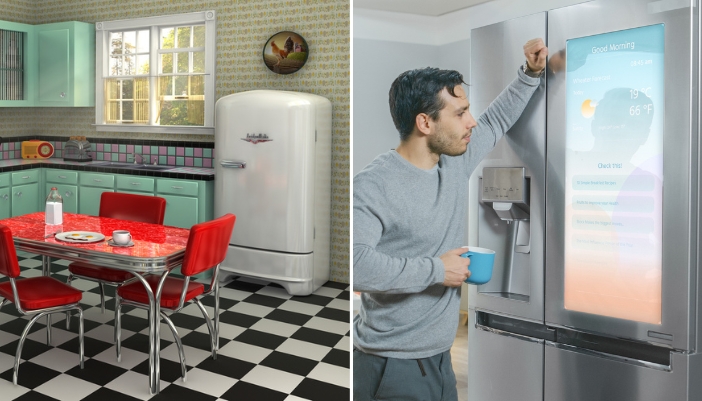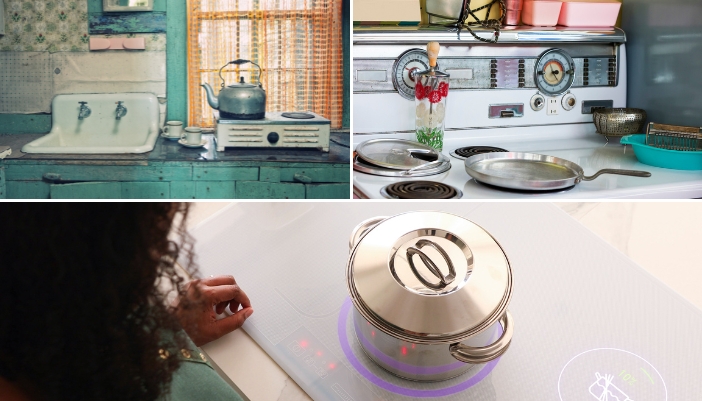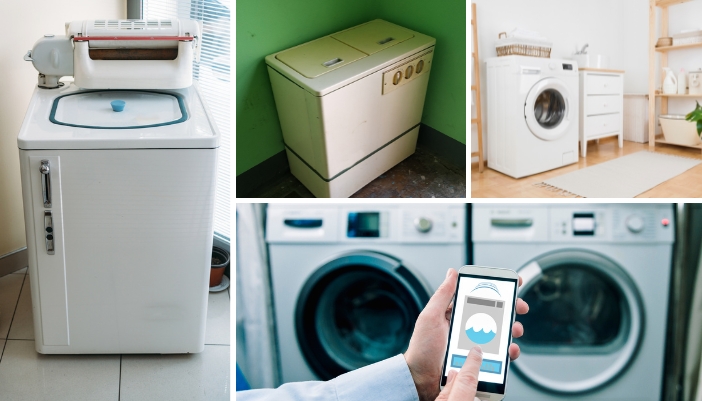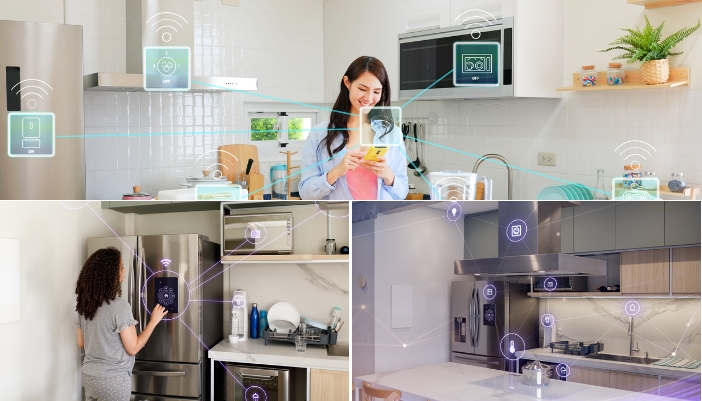Picture this: it's a typical day in your home, but instead of pushing a button to wash your dishes, you're scrubbing away in a sudsy basin. And forget about grabbing a cold drink from the fridge; you're chipping away at a block of ice instead. Sounds like a scene from a historical drama, right? Believe it or not, this was everyday life before countless innovations changed how we do everything!
Today’s home appliances can do so much more than the days before, especially smart appliances. And since National Inventors’ Day is on Sunday (Feb. 11), let’s explore the innovative journey of home appliances and see what future technology might be in store!
The Road So Far:
A Cool Evolution

Let's start our journey through appliance innovation with one of the most essential household items: the refrigerator. Its evolution from basic ice storage to today's smart systems is a tale of constant innovation and improvement.
Ice Harvesting Era: The first iteration of refrigeration meant relying on natural ice, harvested and stored in iceboxes — a cumbersome and unreliable method.
- Mechanical Refrigeration Emerges: The late 1800s brought a revolution with the advent of mechanical refrigeration with vapor compression from inventors like Oliver Evans and John Gorrie. After Alexander C. Twinning improved the systems in 1856, they became more common and accessible.
- The Freon Game-Changer: In the 1930s, Freon was a milestone in refrigerator safety and efficiency. However, its environmental impact led to a pivotal shift in refrigerant technology.
- Shift to Eco-Friendly Refrigerants: The discovery of Freon's harm to the ozone layer spurred the development of CFC-free refrigerants, aligning refrigeration technology with environmental consciousness.
- Era of Smart Refrigeration: Today’s smart refrigerators are energy-efficient, Wi-Fi-enabled, and can be integrated into smart home systems, reflecting the incredible strides made in this field (they can even make a grocery list for you based on what’s missing in the fridge!).
The Heat is On

Keeping things cool is one home essential, but so is turning up the heat! Cooking has come a long way from the hearth fires of yore with the invention of the cooktop!
- Pennsylvania Fireplace: Benjamin Franklin invented a cooker based on a fireplace, which was the precursor for the future kitchen stoves.
- Cooking with Gas: By the early 19th century, gas cooktops were invented and offered more control over the flame while being cleaner than wood or charcoal (but these posed some safety risks!).
- Electric Cooking: Electric cooktops swiftly rose from the early days of platinum-wire coils and hotplates to cooktops with automated temperature control and glass-ceramic tops (first discovered by Donald Stookey in 1953). These were far easier to use!
- Induction: Cooking with electromagnetic induction was actually a thing in the 70s, but newer innovations in the tech have resurged in popularity because of their improved heat efficiency and safety features!
Suds & Science

No matter the age, there was always laundry to be done. But what once took hours of manual labor scrubbing with washboards and beating with rocks is now as easy as load, adding soap, and hitting start!
- John Tyzacke's 1691 Machine: This early washing machine mechanized the washing process by using a machine to beat and agitate clothes.
- Jacob Schäffer's 1767 Design: Schäffer's washing machine design included improvements like a crank and tub, which made the laundry process more effective. This design made washing less labor-intensive by agitating the clothes more efficiently to remove dirt like modern top-load machines.
- Henry Sidgier's 1782 Rotary Drum: Sidgier's rotary washing machine, which featured a barrel with rods and a crank, introduced a turning mechanism that flushed water through clothes more effectively, making it the standard in laundry machines .
- William Blackstone's 1874 Domestic Machine: Blackstone's invention was designed for home use, making washing machines more accessible and practical for domestic chores — less reliance on commercial machines!
- Alva Fisher's 1901 Electric Washer: Fisher's "Thor" was the first electric washing machine featuring an electric motor and a reversing drum, which automated much of the process.
- Modern Washer Innovations: Today's washing machines have advanced features like smart tech that notifies you when a load is done, energy-efficient operation, and water-saving technologies. There are even washer dryer combos and pedestal washers!
From Scrubbing to Loading
As with laundry, doing the dishes is an everyday task. And what once required multiple gallons of water and hand scrubbing now only requires loading the dishes in the washer! But you’d be surprised how old the dishwasher really is!
- Joel Houghton's 1850 Patent: The first mechanical dishwashing device, patented by Joel Houghton, was made of wood and operated by hand, spraying water onto dishes, but it was slow and unreliable.
- William Howard Livens' 1924 Design: In the United Kingdom, William Howard Livens invented a small, non-electric dishwasher in 1924 that incorporated many features of modern dishwashers, such as a door for loading, a wire rack, and a rotating sprayer. And since it coincided with the surge of modern plumbing, it was more practical.
- The First Electric Dishwasher in 1929: Europe's first domestic dishwasher with an electric motor was introduced in 1929, offering a more automated cleaning process and paving the way for electric dishwashers in households.
- Late 1990s Energy Conservation Features: By the late 1990s, dishwashers began incorporating energy-saving features like soil sensors, which measure food particles and adjust washing time accordingly, contributing to water and energy efficiency.
Baking a Difference

Cooking over fire isn’t the only innovation the kitchen has seen — ovens have come a long way, too! Lighting a fire to warm the oven might have been the norm at one point, but now we only need to set the temperature and let the oven do its thing!
- Rumford's Cast Iron Stove: In 1795, Count Rumford invented a cast iron stove with a single fire source but individual temperature regulation for several pots, a precursor to modern ovens. Its design also heated the room, although it was too large for most homes.
- Gas Stoves Emerge: The first recorded use of gas for cooking was by Zachaus Winzler in 1802, but it wasn't until the 1830s that James Sharp introduced the commercially produced gas stove. These stoves became popular due to their ease of temperature regulation and less maintenance than wood or coal stoves.
- Introduction of Electric Ovens: By 1892, electric stoves came into use after the introduction of home electricity. Thomas Ahearn manufactured one of the early models, showcasing its abilities by preparing a meal entirely with electricity.
- Self-Cleaning Ovens: In the 60s, the introduction of self-cleaning ovens significantly reduced manual labor in cleaning things.
- Convection Ovens: Popularized in the 80s, convection cooking brought a fan to circulate hot air around the food, improving cooking efficiency and evenness — most of today’s ovens have a convection cooking feature!
- Programmable Features: The integration of digital displays and programmable features made things like delayed start and precise temperature adjustments possible.
Future Forward

Home appliances have come a long way, but the innovations don’t stop — they keep going! With newer tech becoming available each year, the realm of appliances is changing with it!
- Smart Appliances: These feature more connectivity with a fully operating smart home and offer more capabilities than early smart appliance models.
- Sustainable Focus: More and more manufacturers are emphasizing sustainability with their appliance designs so they reduce water usage, have superior energy efficiency, are solar-power compatible, and are made with eco-friendly materials!
- AI Appliances: In the next few years, we can expect to see AI in appliances to help learn user preferences for personalized experiences. They could also potentially lean into predictive maintenance to extend the appliance's lifespan!
While the future of appliances is still a ways away, you can still enjoy the benefits of the latest home appliance innovations with a simple upgrade from Decker & Sons Whether you want a smart refrigerator telling you what you’re out of, the latest cooking features, or an eco-friendly laundry pair, you’ll find what you need in our appliance selection! And if you have any questions, pop by or give us a call